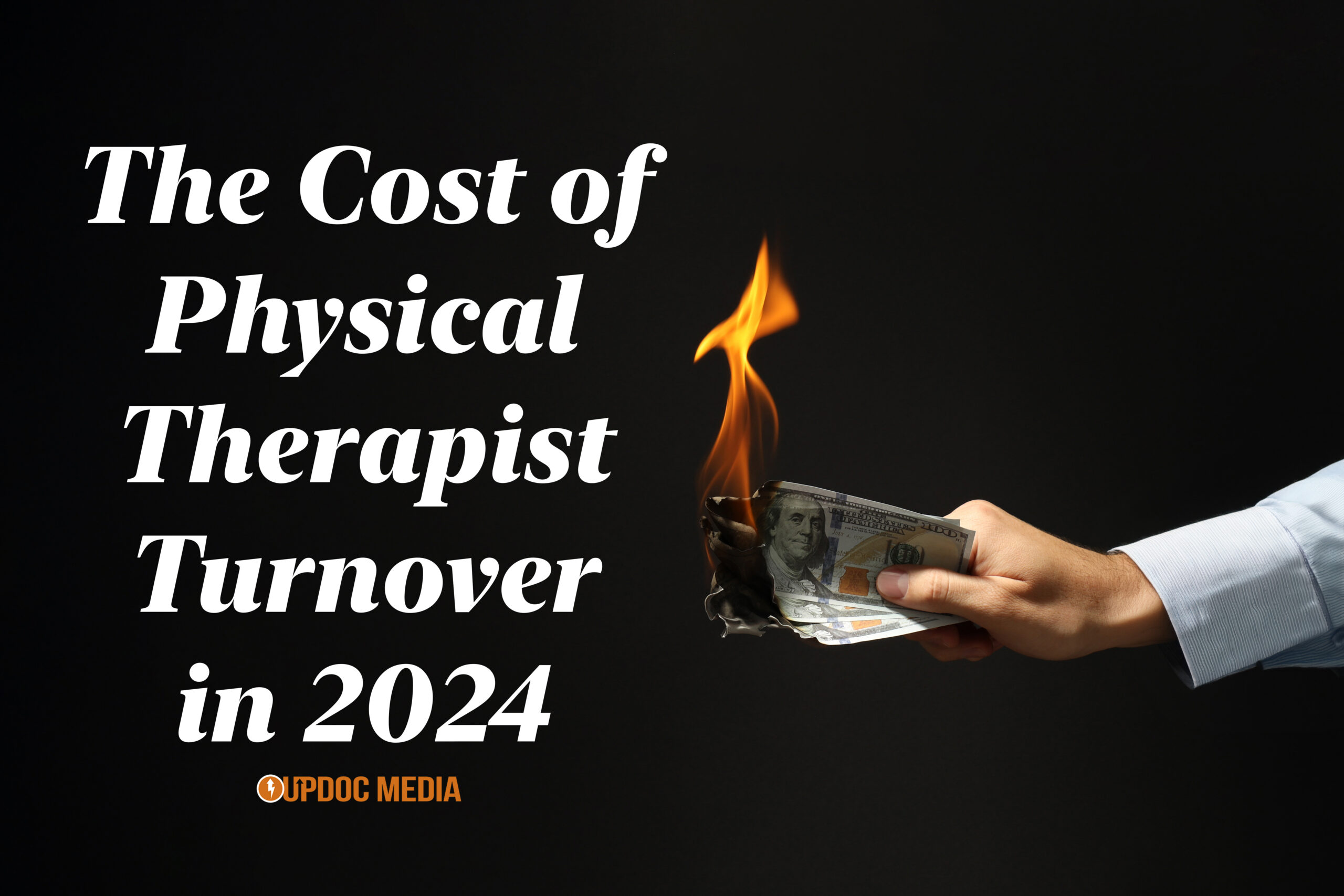
Summary (aka: TLDR...)
- The costs of turnover and staff replacement in physical therapy, allied rehab therapy, and healthcare in general are skyrocketing.
- At a minimum, it takes 15%-30% of the per annum salary equivalent to fill an open position — aka. the cost of turnover.
- The cost of turnover is 36% - 46% as a percent of salary for a 3 month vacancy.
- Another calculation reveals nearly $25k/month to replace a physical therapist for each month the position is vacant.
- A.I. calculations continuously return a result of 120.88% of a PT's annual salary in terms of turnover costs.
- New hires take time to reach full productivity. A study by the Aberdeen Group showed that new hires take an average of 8 months to reach full productivity.
- Volatile job market behaviors can cause incredible financial damage to employer organizations if they are unable to retain employees, and if they are unable to fill open positions in quick succession.
- Retention is key. With retention, less hiring battles need to occur; more money is saved, more talent is developed, and more core competencies are grown between and amongst work teams across an organization.
Historically, it's been generally accepted that to fill any given position, it costs an approximate range of 15-30% of that position's per annum salary equivalent.
A $100,000 job would otherwise cost $15k - $30k, ASSUMING it was an entry level position. Obviously, the most specialized and the more industry factors are considered... the costs go up.

Earlier this year, our team was tinkering with various A.I. calculators to inquire the cost of replacing a physical therapist. At that time (early Q2 2024), the calculators stated:
- 36% of per annum salary equivalent if a position is filled in 3 months or less
- 75-85% of per annum salary equivalent if a position was filled in 6 months or more
This would be an exercise we would explore again, which comprises some interesting calculus that we shall share in the second half of this blog article.
Nevertheless, as most do... we began with a basic Google search. This revealed a few of the following results... with many that simply deferred to the cost of physical therapy as a patient:
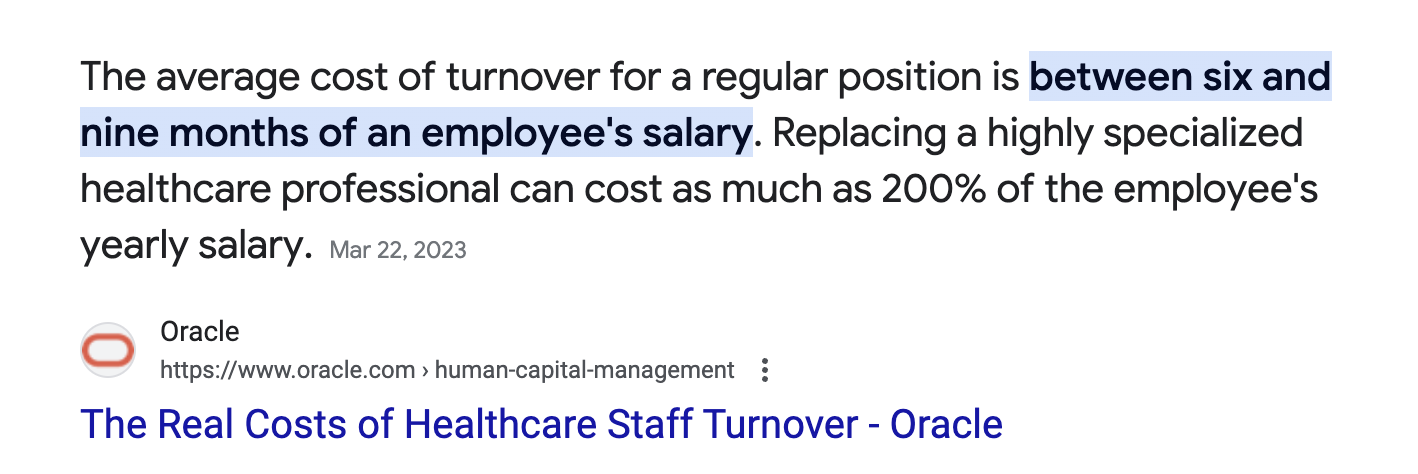





An article by Eddy titled "Employee Replacement Costs" stated that even: "...One of the company’s lower-paying jobs—can cost... around 18% of the position’s yearly total compensation."
An Oracle article titled The Real Costs of Healthcare Staff Turnover stated:
Turnover costs an organization much more than money. There’s the cost of reduced productivity when an employee leaves, and the hiring process itself can be expensive and resource intensive. It costs an employer an average of between six and nine months of an employee’s annual salary to replace them, according to the Society for Human Resource Management, and it can cost as much as 200% of the employee’s annual pay to replace a specialized healthcare professional.
The article went on to note:
Patients notice high turnover rates when they see the impact of poor patient-to-staff ratios. They lose confidence in their healthcare provider when they don’t believe they’re receiving the best care, which can cause reputational damage.

Enter A.I. Calculus
Naturally, we weren't satisfied with generic or nonspecific answers. UpDoc has slews of its own data, however our team was curious as to what the newly developed and recently upgraded A.I. models would say if we were to query the actual costs of filling a new hire physical therapist role.
Ironically enough, asking it initially for "cost of physical therapist turnover" yielded several warnings that the answers may be offensive, inappropriate, or even dangerous.
The following is but a sampling of the results:
First, we started with a general query to see what the industry agnostic costs might be:
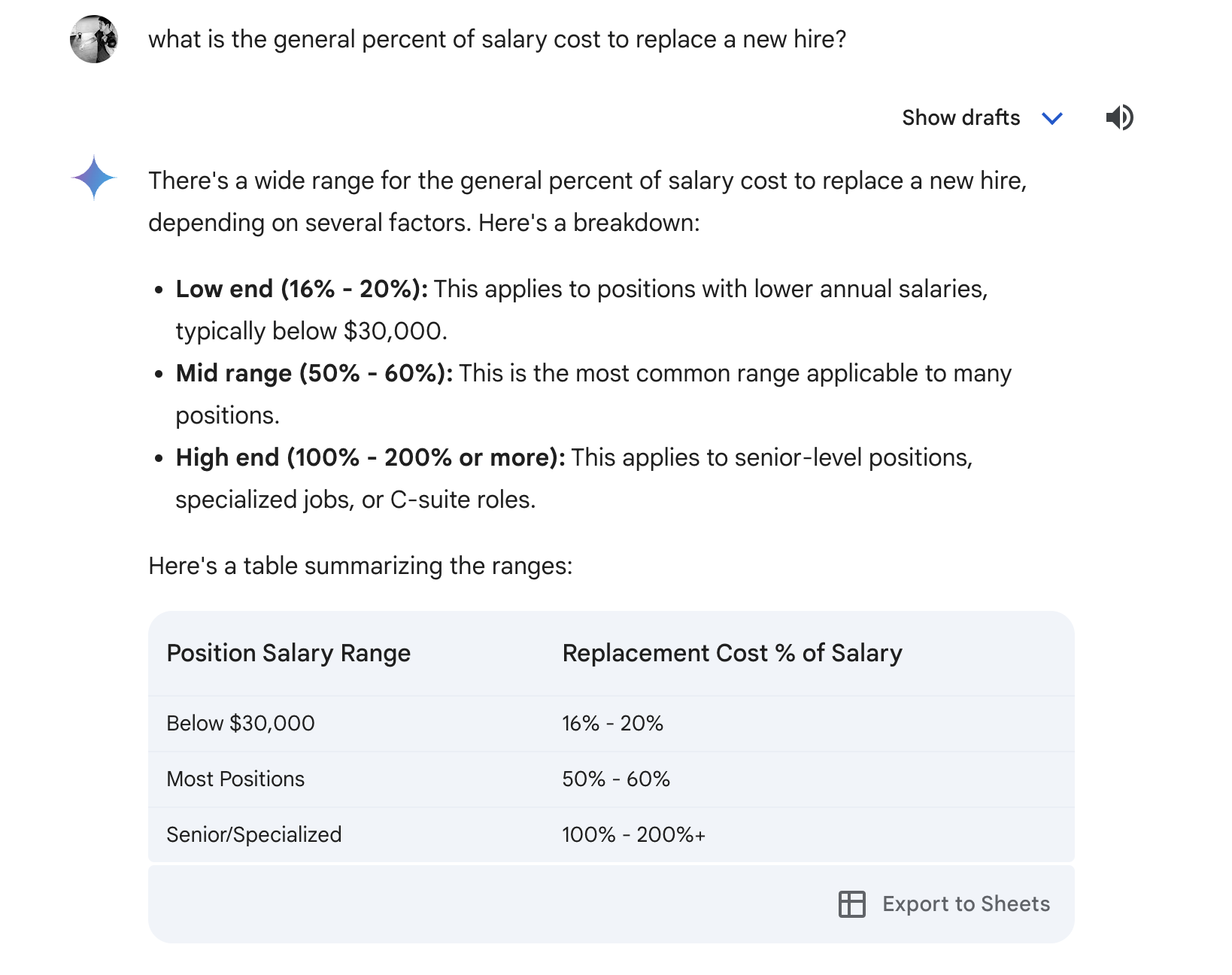
Obviously, we wanted to get industry specific — here were some of the results:
PS. It's actually pretty amazing that these platforms offer a "show me your work" approach — including the code used to come to whichever mathematical results they actually do arrive at.
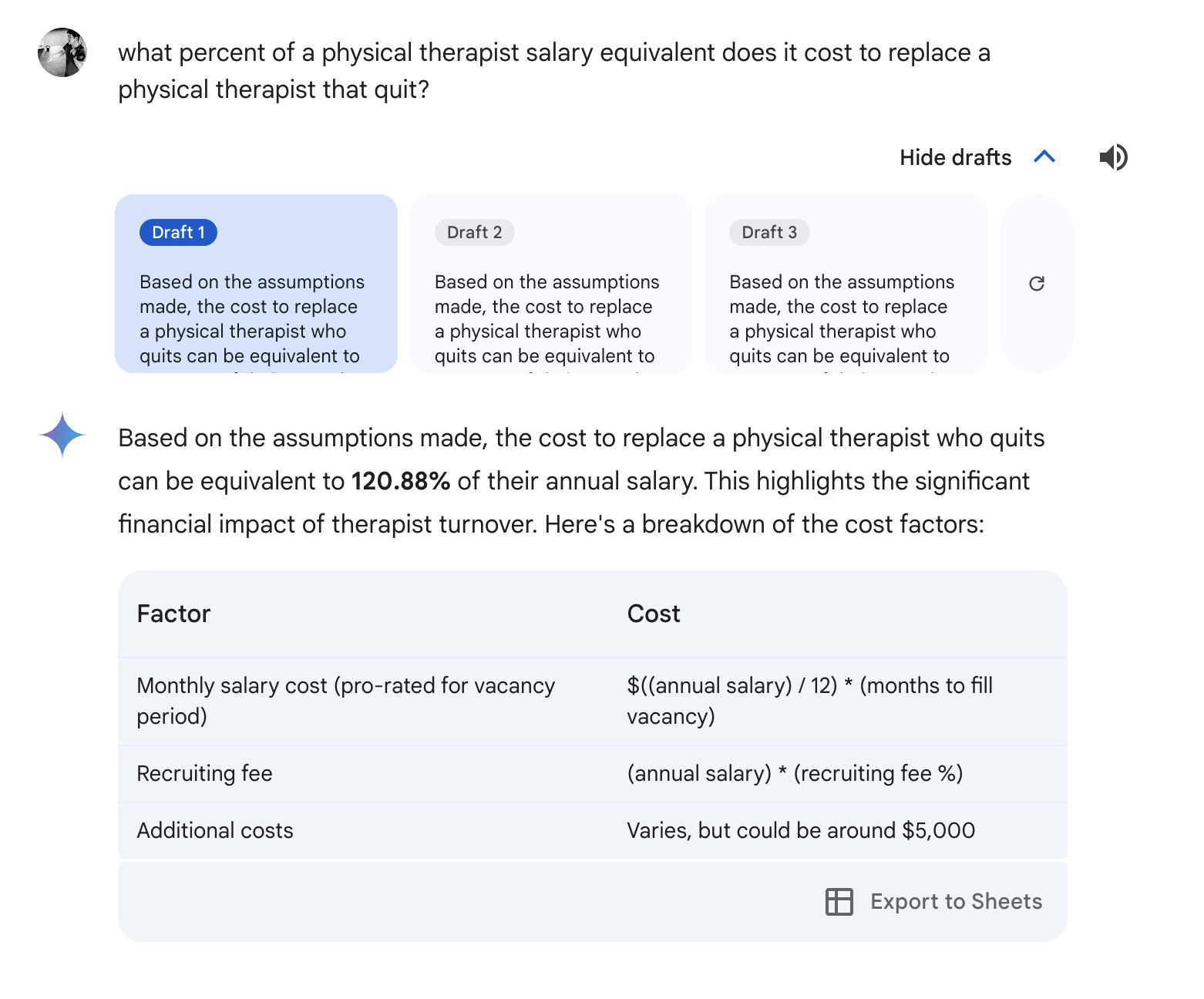
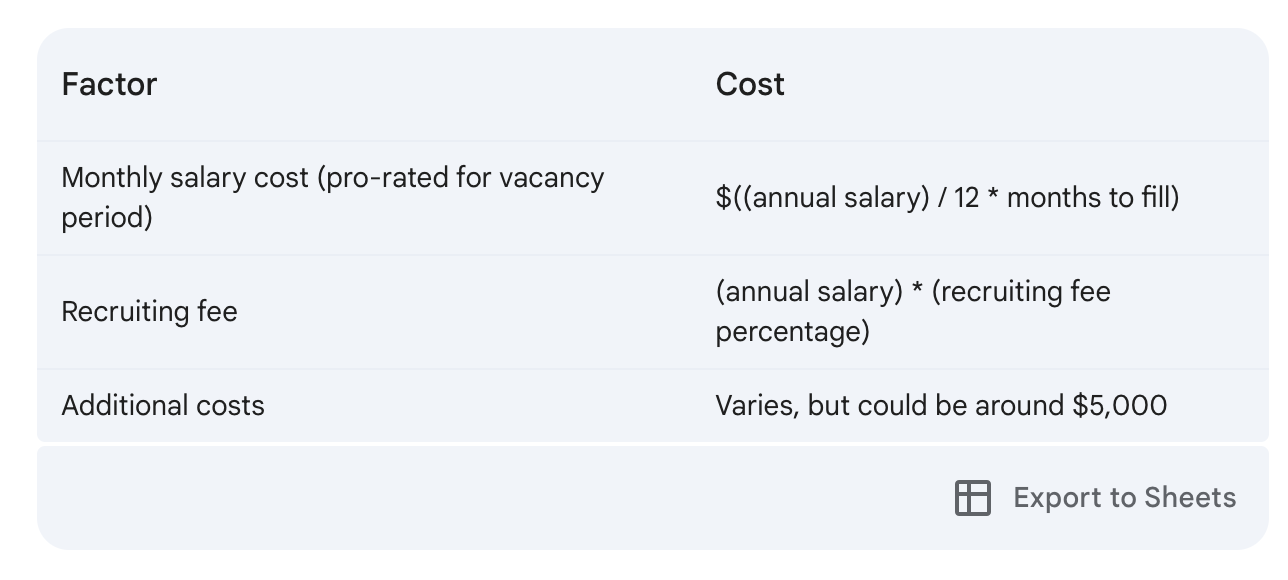

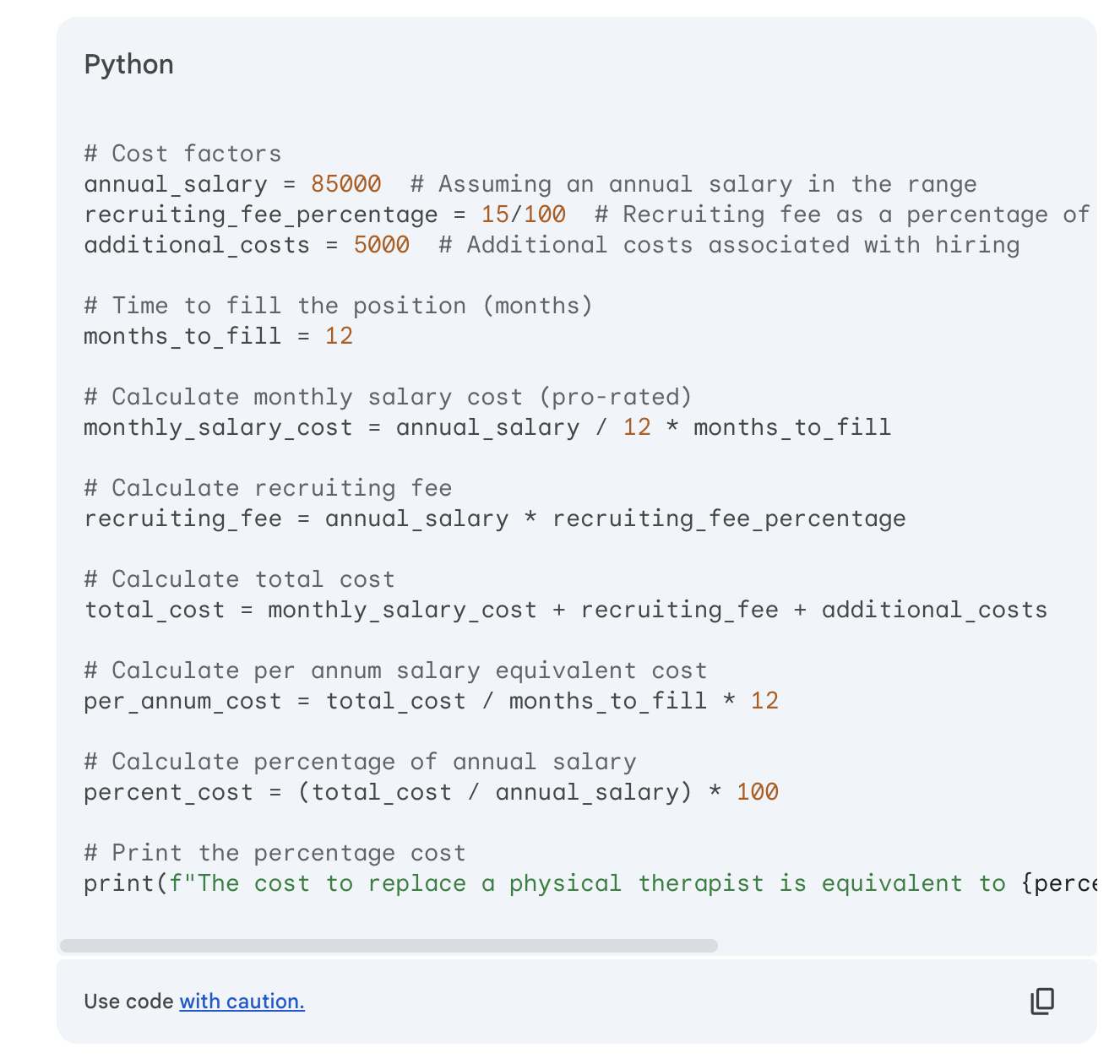
We had many more gos at this query, in many different prompt formats. This one was of interest:

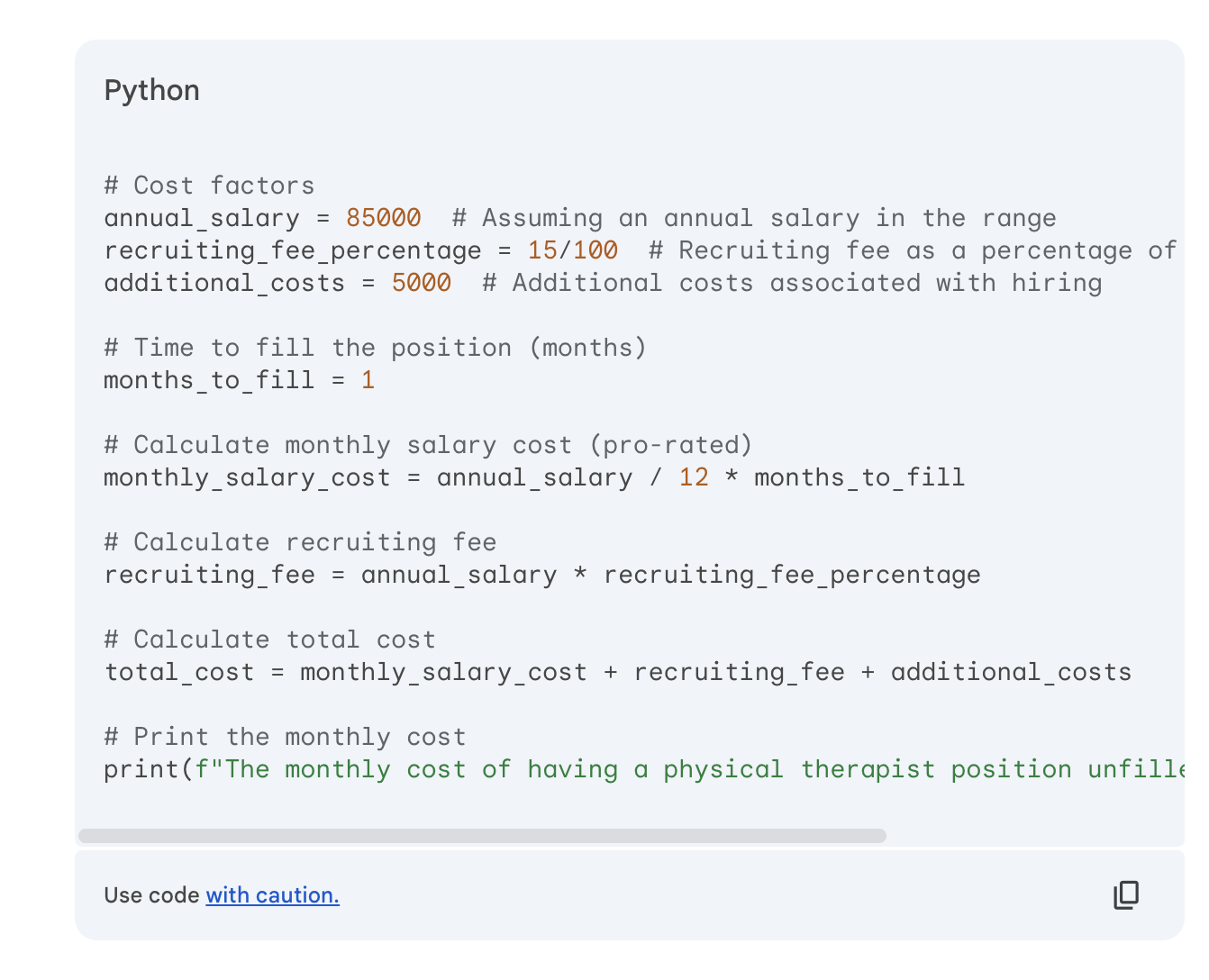
While a departure from the 50% - 100% per annum equivalent range, this one came back down to 30% range to replace a PT... BUT, PER MONTH!
PER MONTH!
We know from the 2024 Talent Acquisition and Retention report that only 36% of hiring managers are filling their open roles in 2 months or less.
Even then, with this calculation... the ACTUAL COST would be around 58% per annum.
So.... back here, we are.
Ultimately, we wanted a true mathematical breakdown of PT replacement costs. Here was the most thorough result:

The general cost to replace a new hire physical therapist can be around 120.88% of their annual salary. Here's a breakdown of the cost factors and the math involved:
Cost factors:
- Annual salary: This is the yearly compensation you'd offer to the new physical therapist (PT). Let's assume an annual salary in the range of $85,000 (this can vary depending on location and experience).
- Recruiting fee: Many practices use recruiters to find qualified PTs. Recruiting fees can range from 15% to 20% of the annual salary [PT Solutions]. We'll use a mid-range of 15% for this example.
- Additional costs: There are other expenses associated with hiring, such as background checks, drug testing, and advertising. These costs can vary but could be around $5,000.
Calculating the total cost:
-
Recruiting fee: Multiply the annual salary by the recruiting fee percentage.
- Recruiting fee = $85,000 * 15% = $12,750.00
-
Total cost: Add the recruiting fee, additional costs, and pro-rated salary for the vacancy period (assuming a 1-month vacancy to find a replacement). In this example, we'll use a 1-month vacancy for illustration purposes, but this cost can significantly increase depending on how long it takes to fill the position.
- Total cost = Recruiting fee + Additional costs + (Monthly salary * Vacancy months)
- Monthly salary = Annual salary / 12 months = $85,000 / 12 months = $7,083.33
- Total cost = $12,750.00 + $5,000.00 + ($7,083.33 * 1 month)
- Total cost = $19,833.33
-
Percent of salary cost: Divide the total cost by the annual salary and multiply by 100% to express it as a percentage.
- Percent of salary cost = (Total cost / Annual salary) * 100%
- Percent of salary cost = ($19,833.33 / $85,000) * 100%
- Percent of salary cost = 23.33% (rounded to two decimal places)
Important Note: The 23.33% we calculated represents the cost to replace a PT with a 1-month vacancy. In reality, it often takes longer to fill a vacant PT position. So, if we consider a more realistic scenario with a 3-month vacancy:
- Total cost (3-month vacancy) = $12,750.00 + $5,000.00 + ($7,083.33 * 3 months)
- Total cost (3-month vacancy) = $39,000.00
- Percent of salary cost (3-month vacancy) = ($39,000.00 / $85,000) * 100%
- Percent of salary cost (3-month vacancy) = 45.88% (rounded to two decimal places)
As you can see, the cost to replace a PT increases significantly as the vacancy period gets longer. Therefore, the 120.88% figure we mentioned earlier considers a more extended vacancy period (around 12 months) which can be a more realistic scenario. This highlights the importance of filling vacant PT positions quickly to minimize the financial impact.
Funny enough, the A.I. model didn't really like the idea of calculating turnover directly until many prompts were first entered for it to build a mathematical base. Here was the most compelling result:

Here's how to estimate the turnover cost:
-
Direct Costs:
- Calculate the sum of recruiting fees, additional costs, and pro-rated salary for the vacancy period.
-
Indirect Costs:
- Quantify lost revenue due to the vacancy (more challenging to estimate accurately).
Example Calculation (Direct Costs):
- Annual Salary: $85,000
- Recruiting Fee (15%): $12,750.00
- Additional Costs: $5,000.00
- Vacancy Period (3 months):
- Monthly Salary: $7,083.33
- Pro-rated Salary: $7,083.33 * 3 months = $21,250.00
Total Direct Cost (3-month vacancy): $12,750.00 (Recruiting Fee) + $5,000.00 (Additional Costs) + $21,250.00 (Pro-rated Salary) = $39,000.00
Percent of Salary Cost: Divide the total direct cost by the annual salary and multiply by 100%.
Percent of Salary Cost (3-month vacancy): ($39,000.00 / $85,000.00) * 100% = 45.88%
What about winning? What are the positives to be gained with employee retention?
One of the most interesting (and, fun!) aspects of using A.I. for calculations is that it builds on itself; requiring the user to be savvy with prompt syntax, be understanding of data structure, and host a certain art of "the ask."


Reduced Costs:
- Lower Turnover Costs: As we discussed earlier, replacing a physical therapist can cost 45.88% to 123.53% of their annual salary, depending on the vacancy period. Retention reduces these recruitment and onboarding expenses.
- Increased Productivity: New hires take time to reach full productivity. A study by the Aberdeen Group showed that new hires take an average of 8 months to reach full productivity [Aberdeen Group]. This translates to lost revenue during the ramp-up period. Retained employees are already familiar with the company, processes, and systems, allowing them to be more productive from the start.
- Reduced Training Costs: The cost of training new employees can be significant. The Association for Talent Development (ATD) research suggests an average cost per hour of employee training to be $1,275 [ATD]. With high turnover, these training costs become recurring expenses. Retaining employees eliminates the need for constant retraining.
Financial Gains:
- Increased Revenue: Retained employees are more productive and have better customer satisfaction skills, leading to higher sales and revenue generation.
- Improved Customer Satisfaction: Employee turnover can disrupt customer relationships. Retained staff build rapport with clients, leading to improved customer satisfaction and loyalty, which can translate to repeat business and positive word-of-mouth marketing.
- Reduced Legal Costs: High turnover can lead to legal issues, such as wrongful termination lawsuits. Retaining employees minimizes these potential legal expenses.
Non-Financial Benefits:
- Improved Morale: High turnover can create a negative and stressful work environment. Retaining employees fosters a more positive and collaborative work atmosphere.
- Stronger Company Culture: Retained employees understand and embody the company culture, leading to a more cohesive and efficient work environment.
- Institutional Knowledge: Retained employees accumulate valuable knowledge and experience specific to the company and its operations. This institutional knowledge is crucial for maintaining a competitive edge.
- Innovation and Problem-Solving: Retained employees are more invested in the company's success and are likely to contribute to innovation and problem-solving due to their experience and understanding of the company's goals.
In Summary:
Employee retention offers a significant return on investment (ROI) for companies. By minimizing turnover costs, increasing productivity, and fostering a positive work environment, companies can achieve higher profitability, customer satisfaction, and innovation. While calculating the exact ROI can be complex, the potential financial and non-financial benefits make employee retention a strategic priority for any organization.
Reliable and Meaningful Conclusions
Calculations can get convoluted at times... this is true. However, like most things, if you see a general trend of things moving in the same 90 degree arc... one might just want to pay attention to that trend.
Turnover Costs Are Watered Down
If anything, we've demonstrated through both research, reporting, and A.I. that the costs of turnover are not only high — they are likely an underestimation in terms of the financial damage it costs to employers.

To Retain Is to Gain
There is simply too much to gain in retaining employees — especially the right ones. Similar to the Harvard Business Review studies, acquiring new customers can cost 5 to 25 times more than to retain an existing one. With staff, it may be even more than that given the downstream costs of losing top talent.

The Secret Behind Winning At Hiring Is...
Developing a workplace environment that excels in retention. New data from the Practice Management Report and the Talent Acquisition Report series demonstrates that organizations have a positive scaling affect when it comes to having underlying positive factors that contribute to better retention, AND how it has a winning affect on attracting new hires.

Next Steps To Consider
Things you can do today:
- Review your average time to new hire for your organization. Multiply that average against the range of costs from 30% to 120% to see what you are likely, and actively losing as a "cost of doing business."
- We know that for most employees that turnover, they do so because of difficulties in their daily work with management (Talent Acquisition and Retention Report 2024). Consider recent and recurrent staff feedback regarding line and middle management. What are the common threads? What can I publicly acknowledge TODAY in from of my staff, and actuate measurable change for in 2-4 weeks or less?
- Last but not least, calculate your gain-loss-ratio in terms of the ongoing turnover "cost of doing business" versus how much it may "cost" you to actively participate in strategies to both retain, and by proxy... create an attractive work environment for A-List new hires.
Content to explore:
Leveraging Business Intelligence for Workforce Strategies
For those hiring managers and decision makers ready to take action, we encourage you to explore UpDoc's very own workforce intelligence platform — specifically calibrated for physical therapy and allied rehab therapy for employee retention and positioning for new hire acquisitions.
 — CLICK HERE.
— CLICK HERE.








